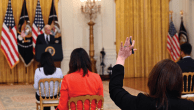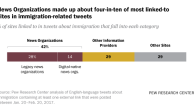Summary of Findings
The public continued to closely track news about health care reform last week, while the media divided its attention across a range of foreign and domestic stories.

A third (33%) of the public says they followed the debate over health care reform more closely than other top stories last week, while 22% followed reports about the condition of the U.S. economy most closely. According to the latest weekly News Interest Index survey, conducted October 2-5 by the Pew Research Center for the People and the Press, one-in-ten followed news about earthquakes in Indonesia and a tsunami in the South Pacific most closely, while 9% named talks between the United States and Iran over Iran’s nuclear program as their top story.
Though a growing percentage of Americans say coverage of the health care debate has been excessive (21%), almost twice as many (40%) say the amount of coverage has been about right. The public also still finds the debate about health care reform important (94%), but hard to understand (66%).
A separate news content analysis by the Pew Research Center’s Project for Excellence in Journalism (PEJ) finds that health care reform received about as much coverage as other leading stories last week, including U.S.-Iran talks and economic news.
Coverage of the health care debate filled 11% of the newshole, while 10% of news reports focused on Iran. Economic news accounted for 9% of coverage. More than four-in-ten Americans (44%) say they followed economic news very closely last week, a reading that has been steady over the past month. Some 39% followed the debate over health care reform very closely, down slightly from the previous week (45%).
Too Much Coverage?

Relatively few say news organizations have given “too much” coverage to the debate over health care reform, the economy, or talks between U.S. and Iran. For all three stories, more say there has been the right amount of coverage.
About two-in-ten (21%) say there has been too much coverage of the health care debate. Four-in-ten say news organizations have given the debate the right amount of attention, while 35% say there has been too little coverage.
While still a minority viewpoint, the percentage saying there has been too much coverage of the debate over health care reform has grown since mid-July, when only 6% thought coverage was excessive. In the current survey, Republicans (30% too much) are more likely than Democrats (16% too much) or independents (19% too much) to say coverage has been excessive.
Views of economic coverage are similar. About two-in-ten (22%) say there has been too much economic coverage, while 44% say the right amount and 32% say too little. Fewer say there has been too much coverage of talks between the United States and Iran over Iran’s nuclear program (14%), a story that has developed relatively recently as opposed to longer running news about the economy and health care reform. Almost half (48%) say news organizations have devoted the right amount of coverage to talks between the United States and Iran, while a third (33%) says there has been too little coverage.
Arrival of Swine Flu Vaccine Registers Widely

Half the public say they have heard a lot about the arrival of the swine flu vaccine at hospitals, clinics and schools, while another 40% say they’ve heard a little about this. Women (55%) are somewhat more likely than men (44%) to have heard a lot about the arrival of the vaccine. Overall, just 10% say they have heard nothing about the flu vaccine.
About four-in-ten (42%) say they heard a lot about Barack and Michelle Obama traveling to Copenhagen to lobby for Chicago’s Olympic bid; 37% heard a little, while 20% heard nothing at all. The efforts of the president and his wife on behalf of Chicago’s failed bid registered more broadly with Republicans (55% a lot) than with Democrats (39%) or independents (40%).
Somewhat fewer say they heard a lot about talk show host David Letterman acknowledging affairs with staffers and a blackmail attempt (37%). Some 36% heard a little about this, while 28% heard nothing at all.
News about a nearly complete fossil that may be the earliest known human ancestor did not make much of an impression with the public. Just 9% heard a lot about the story, 36% say they heard a little, but a 54% majority says they heard nothing at all about the fossil.
Health Care Reform Still Hard to Understand

There has been no change in perceptions about the issue of health care reform, with majorities continuing to say that the issue affects them personally, is important, and is interesting. At the same time, most still say that the debate is hard to understand.
There is near consensus that health care reform is important: 94% of the public says this. In addition, broad majorities say the issue affects them personally (74%) and is interesting (71%). And despite being a closely followed and highly covered story throughout the summer, 66% say health care reform is still hard to understand, little changed from the percentages who said this is mid-July (63%) and early September (67%).
These findings are based on the most recent installment of the weekly News Interest Index, an ongoing project of the Pew Research Center for the People & the Press. The index, building on the Center’s longstanding research into public attentiveness to major news stories, examines news interest as it relates to the news media’s coverage. The weekly survey is conducted in conjunction with The Project for Excellence in Journalism’s News Coverage Index, which monitors the news reported by major newspaper, television, radio and online news outlets on an ongoing basis. In the most recent week, data relating to news coverage were collected from September 28-October 4, 2009 and survey data measuring public interest in the top news stories of the week were collected October 2-5, 2009 from a nationally representative sample of 1,000 adults.
About the News Interest Index
The News Interest Index is a weekly survey conducted by the Pew Research Center for the People & the Press aimed at gauging the public’s interest in and reaction to major news events.
This project has been undertaken in conjunction with the Project for Excellence in Journalism’s News Coverage Index, an ongoing content analysis of the news. The News Coverage Index catalogues the news from top news organizations across five major sectors of the media: newspapers, network television, cable television, radio and the internet. Each week (from Monday through Sunday) PEJ compiles this data to identify the top stories for the week. The News Interest Index survey collects data from Friday through Monday to gauge public interest in the most covered stories of the week.
Results for the weekly surveys are based on landline telephone interviews among a nationwide sample of approximately 1,000 adults, 18 years of age or older, conducted under the direction of ORC (Opinion Research Corporation). For results based on the total sample, one can say with 95% confidence that the error attributable to sampling is plus or minus 3.5 percentage points.
In addition to sampling error, one should bear in mind that question wording and practical difficulties in conducting surveys can introduce error or bias into the findings of opinion polls, and that results based on subgroups will have larger margins of error.
For more information about the Project for Excellence in Journalism’s News Coverage Index, go to www.pewresearch.org/pewresearch-org/journalism.




